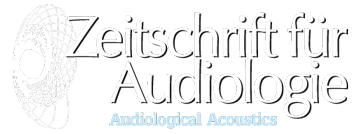Ein alternatives Maß für die Amplitude elektrophysiologischer Reizantworten
The effective response amplitude of evoked potentials: A useful alternative to the conventional linear amplitude difference
Sebastian Hoth
Zusammenfassung: Hintergrund: Die Amplitude der Komponente J5 unter den frühen akustisch evozierten Potentialen wird in der praktischen audiologischen Diagnostik für die Bestimmung der Hörschwelle und vereinzelt auch als Kriterium für ein mögliches Recruitment genutzt. Voraussetzung für diese Anwendungen ist ein aussagekräftiges und gegenüber Störeinflüssen robustes Amplitudenmaß. Der konventionellen Amplitudendifferenz wird hier als Alternative die Effektivamplitude gegenübergestellt.
Methode: Mit der Bestimmung der Koordinaten von J5 wird ein Zeitfenster für die Berechnung der Effektivamplitude festgelegt. Bezogen auf die Reststörung σ ergibt diese Größe ein für die Ermittlung der Reizantwortschwelle nutzbares Signal/Rausch-Verhältnis. Anhand von 1782 FAEP-Messungen (Click-BERA) an 71 Patienten unterschiedlichen Alters und Hörvermögens wurde die Reliabilität dieser Schwellenbestimmung geprüft. Anhand einer zweiten Stichprobe von 39 normalhörenden Probanden wurde die mittlere Normalkennlinie der Effektivamplitude erzeugt.
Ergebnisse: Amplitudendifferenz und Effektivamplitude erweisen sich, wenn beide Größen definiert sind, als hoch korreliert (99,3%). Bei Messkurven, in denen für den erfahrenen Untersucher keine Reizantwort identifizierbar ist, liegt die Effektivamplitude zu 93% unter der Grenze von 2 σ (Sensitivität). Wird eine Sensitivität von 96% gefordert, dann muss die Grenze auf 2,2 σ angehoben werden und die Spezifität beträgt 69%. Die in Bezug auf die Maßeinheit skalierten Normalkennlinien beider Amplitudenmaße stimmen bei Reizpegeln von 40 dB nHL und darüber exakt miteinander überein (bis auf eine Proportionalitätskonstante); bei Annäherung an die Schwelle nimmt der Mittelwert der Effektivamplitude in stärkerem Maße ab als der der linearen Amplitudendifferenz.
Schlussfolgerung: Die Effektivamplitude unterstützt die individuelle Schwellenbestimmung sowohl visuell wie auch numerisch. Ihre mittleren Normalwerte sind im gesamten Pegelbereich gültig und daher als Referenzmaß besser geeignet als die lineare Amplitudendifferenz. Das hier vorgestellte Konzept enthält keinerlei Annahmen, die seine Gültigkeit auf eine in Bezug auf Reiz und Latenzzeit begrenzte Gruppe von AEP beschränkt.
Schlüsselwörter: Frühe akustisch evozierte Potentiale, FAEP, Amplitude, BERA, Schwellenobjektivierung
Abstract: Background: In practical audiological diagnostics, the amplitude of the component J5 among the auditory brainstem responses is used as a measure for the perception threshold and further as criterion for a possible loudness recruitment. These applications require a precise quantity which is stable against contamination by background signals. In this paper, the effective response amplitude Aeff is presented as an alternative to the conventional amplitude difference Alin.
Method: At the instant of tagging the component J5, a time window for the computation of Aeff is established. In relation to the residual noise σ, this quantity yields a signal to noise ratio which is useful for the determination of the response threshold. The reliability of this method was analyzed on the basis of the data from 1782 click-evoked FAEP recordings. A second sample of 39 normal hearing subjects was explored in order to study the mean values of Aeff in the whole range of stimulus levels.
Results: Effective amplitude and linear amplitude difference are highly correlated (99.3%) whenever both quantities are defined. In curves recorded around or below threshold, in which the amplitude difference is not defined, the effective amplitude lies below the limit of 2 σ in 93% of all cases. To achieve a higher sensitivity of 96%, the limit must be raised to 2.2 σ and the associated specificity amounts to 69% according to the receiver operating characteristic (ROC). Regarding the calibrated mean normal values, Aeff and Alin coincide at stimulus levels 40 dB nHL and above (except for a proportionality constant). At lower levels, the mean value of Aeff is lower than that of Alin.
Conclusion: The effective response amplitude Aeff supports the individual threshold determination both visually and numerically. Its average normal values are valid in the entire level range even below the response threshold and are therefore better suited as a reference measure than the amplitude difference Alin. The method does not make use of any assumptions which limit its validity to a group of potentials with respect to stimulus or latency.
Keywords: Auditory brainstem responses, ABR, amplitude, objective threshold
